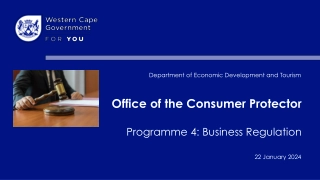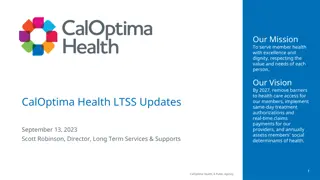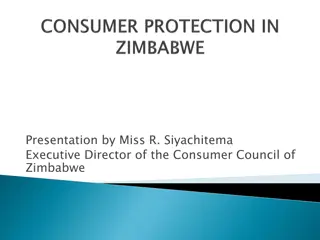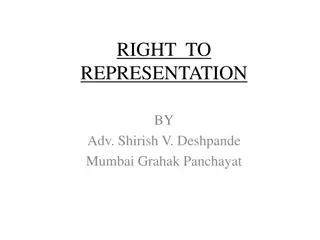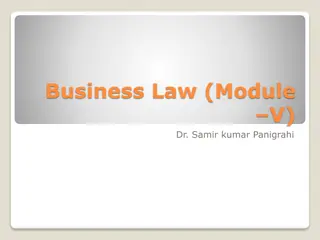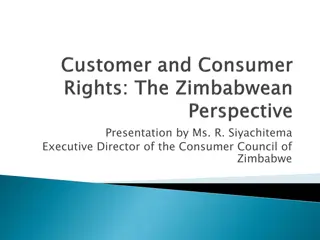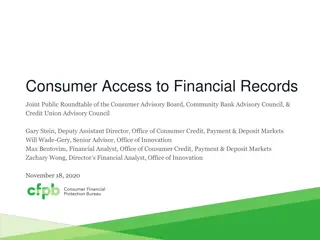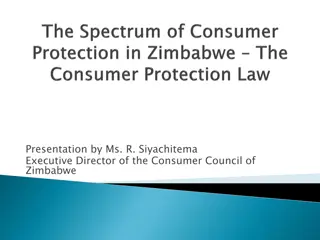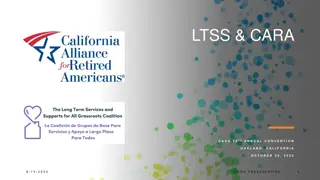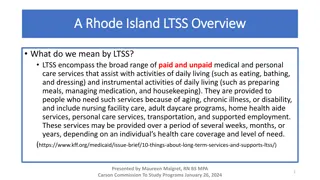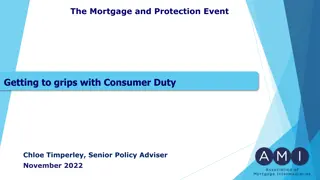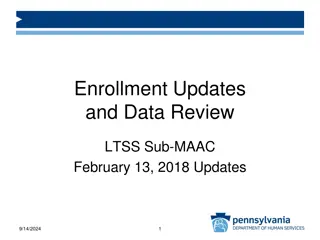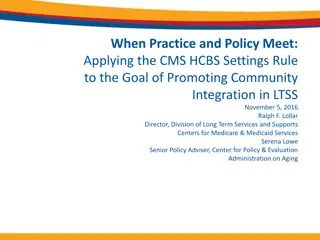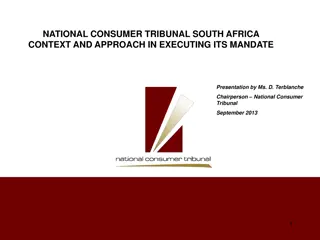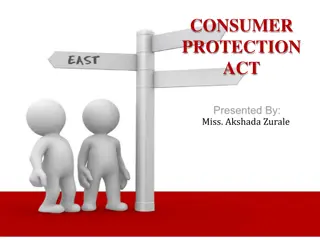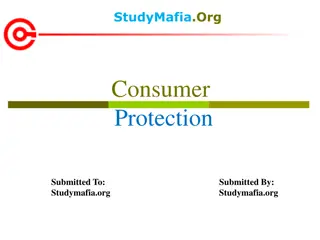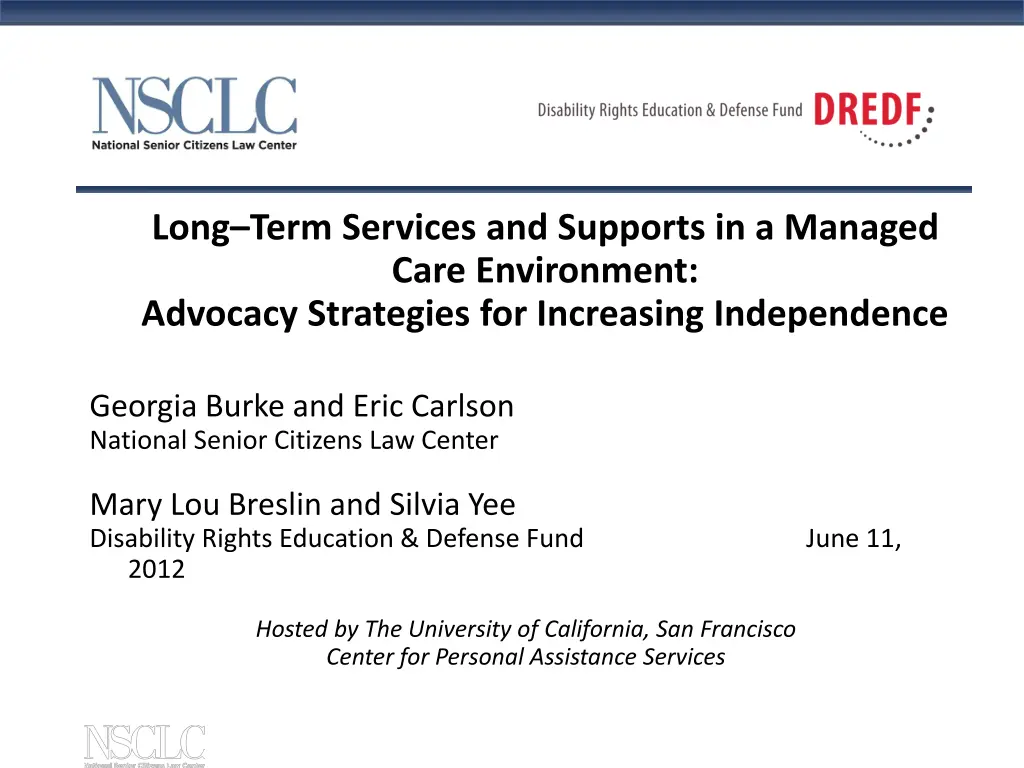
Enhancing Long-Term Care Advocacy Strategies
Explore advocacy strategies for increasing independence in long-term care within a managed care environment, presented by expert speakers. Learn about beneficiary protections, consumer protection categories, and the mission of organizations dedicated to safeguarding the rights of individuals with disabilities and older adults.
Download Presentation

Please find below an Image/Link to download the presentation.
The content on the website is provided AS IS for your information and personal use only. It may not be sold, licensed, or shared on other websites without obtaining consent from the author. If you encounter any issues during the download, it is possible that the publisher has removed the file from their server.
You are allowed to download the files provided on this website for personal or commercial use, subject to the condition that they are used lawfully. All files are the property of their respective owners.
The content on the website is provided AS IS for your information and personal use only. It may not be sold, licensed, or shared on other websites without obtaining consent from the author.
E N D
Presentation Transcript
LongTerm Services and Supports in a Managed Care Environment: Advocacy Strategies for Increasing Independence Georgia Burke and Eric Carlson National Senior Citizens Law Center Mary Lou Breslin and Silvia Yee Disability Rights Education & Defense Fund 2012 June 11, Hosted by The University of California, San Francisco Center for Personal Assistance Services
O Founded in 1979, by people with disabilities and parents of children with disabilities, the Disability Rights Education and Defense Fund (DREDF) is a national law and policy center, based in Berkeley, CA, dedicated to protecting and advancing the civil rights of people with disabilities. www.dredf.org.
Housekeeping Questions: Type in the lower of the two boxes on the left of your screen. Send to moderators Technical issues: email narevalo@nsclc.org Captioning: Go to upper row on your screen and select Windows , then select Close Captioning. Accessible to screen readers. www.NSCLC.org
NSCLC The National Senior Citizens Law Center is a non- profit organization whose principal mission is to protect the rights on low-income older adults. Through advocacy, litigation and the education and counseling of local advocates, we seek to ensure the health and economic security and preserve access to the courts for those elders with limited income and resources. www.NSCLC.org
LTSS: Beneficiary Protections in a Managed Care Environment Increasing reliance on managed care to deliver LTSS in Medicaid and as part of integrated Medicaid/Medicare delivery systems. Tool kit jointly developed by NSCLC and DREDF 15 areas of consumer protections Drill down with specific recommendations applicable to LTSS www.NSCLC.org
Consumer Protection Categories Managed Care Plan Infrastructure HCBS Benefit Packages Provider Choice and Access Care Continuity Person Centered Care Planning Self direction Assessments Care Transitions Appeals and Grievances Ombudsman Stakeholder Involvement Civil Rights Financing Oversight/Monitoring Quality Measurements www.NSCLC.org
Managed Care Context Overview State contracts with MCOs Capitated payment Few LTSS in provider benefit packages Trends More Medicaid seniors/PWDs in MCOs States expanding MCO role to include LTSS (full or partial) Snapshot of the state-of-the-states Concerns, risks, and potential opportunities www.dredf.org
Managed Care Context Snapshot of state-of-the-states 29 states PACE program with 200,000 enrollees As of May 2012 16 states have MMLTSS programs; 16 target seniors 11 target PWDs; 8 of these for people with IDD and 8 serve children Enrollment from 200 400,000 (Texas) # of MMC contractors from 1 to 18 (Michigan) 10 states have voluntary enrollment; 9 are mandatory 10 programs offer self direction 26 states posted draft proposals; 11 official proposals www.dredf.org
Managed Care Context Concerns MCOs unfamiliar/uncomfortable with LTSS steep learning curve ahead Can MCOs demonstrate LTSS competency? Can core principles independent living, HCBS, consumer control be preserved? Will LTSS in MCOs advance rebalancing? Defining community in HCBS group homes? www.dredf.org
Managed Care Context Risks Disruption in continuity of Care (COC) HCBs and Personal Assistance Services (PAS) will require medical justification MCOs will deny service; underserve MCOs will reduce provider rates State reduction of Medicaid LTSS funding Quality longstanding concerns w/ MMC, LTSS www.dredf.org
Managed Care Context Potential Opportunities Integration: improving/coordinating/integrating LTSS & healthcare Rebalancing: shift focus from institutional care to HCBS Prevention: reduce nursing home placements Cover cost effective alternatives to covered services www.dredf.org
Benefit Packages www.NSCLC.org
Opportunity to Rebalance States LTSS System MCO liable for costs, & thus with incentive to choose HCBS over facility-based care MCO responsible for coordinating care Opportunity for state to set coordination standards www.NSCLC.org
No Arbitrary Limit on HCBS Enrollment No wait lists!!!!!!!!! States are leery due to feared financial impact Need to argue that HCBS is cost-effective overall See, e.g., Kaye, Gradual Rebalancing of Medicaid LTSS Saves Money and Serves More People, 31 Health Affairs 1195 (2012) www.NSCLC.org
Beware Cagey Language in Proposals E.g., Michigan dual-eligible proposal as the cap on the current [HCBS] waiver is lifted . (p. 26) BUT proposal also says demonstration has potential for addressing the significant wait, depending on how the waiver and the demonstration relate. (p. 32) www.NSCLC.org
Florida Proposes to Retain Waiting Lists Combined Section 1915(b),(c) proposal Medicaid only Proposes to retain enrollment cap of 45,000 throughout five years of waiver www.NSCLC.org
Services Must Be Adequate At a minimum, MCO must provide services required by underlying program (Medicaid and/or Medicaid) At least same amount, duration and scope www.NSCLC.org
Ideally, Additional Services E.g., Virginia dual-eligible proposal adds person-centered care coordination and case management Including care transition programs in hospitals and nursing facilities (pp. 17-20) www.NSCLC.org
Other Optional Services E.g., Virginia (pp. 20-21) Vision Dental Assistive technology Environmental modifications www.NSCLC.org
Service Array Under Community First Choice Option Required Assistance with ADLs, IADLs, etc. Optional: Transition Costs Rent Deposits Bedding Basic kitchen supplies 42 C.F.R. 441.520(b)(1) www.NSCLC.org
Provider Choice www.NSCLC.org
Are Provider Networks Adequate? Do research at the beginning E.g. Oregon dual-eligible proposal MCOs taking proactive approach to network development via a required community needs assessment (pp. 20-21) Updated annually Info on community health needs, health disparities, barriers to care, & utilization patterns www.NSCLC.org
Retain Small Providers Providers should not be excluded for lack of administrative/billing capacity MCO should be required to provide necessary support www.NSCLC.org
Care Transitions www.NSCLC.org
Multiple Factors Benefit packages (already discussed) Assessment and care planning (to be discussed subsequently) Targeted programs E.g., Nursing home diversion programs, Money Follows the Person Appropriate financial incentives to MCOs Ability to retain previous residence www.NSCLC.org
Making Financial Incentives Work No carve-out of nursing facility expenses E.g., Arizona, Hawaii, Minnesota, Tennessee www.NSCLC.org
Varying Rates a Possibility Blended rate E.g., in AZ, if higher HCBS usage, state splits saving with MCO Relatively higher rates for HCBS, compared to nursing facilities See Leslie Hendrickson & Laurel Mildred, Flexible Accounting for Long-Term Care Services: State Budgeting Practices that Increase Access to Home- and Community-Based Services (Scan Foundation Jan. 2012) www.NSCLC.org
What if HCBS Is the High-Cost Option? Potentially, risk pools for high-cost HCBS, in order to spread risk E.g., recent Mass. announcement re: dual-eligible proposal www.NSCLC.org
Keeping Providers: Retainer Payments Retainer payments allow for retention of LTSS provider during stay in hospital or nursing facility Authorized by CMS s Olmstead Update No. 3 (July 25, 2001) www.NSCLC.org
Keeping Residence Program should offer income allocation or benefit to allow retention of home, if nursing facility resident to return within 6 months See Medicaid income allocations at 42 C.F.R. 435.725(d), 435.733(d), 435.832(d). www.NSCLC.org
Retention of Assisted Living Rooms Require room holds, or comparable right under state s landlord/tenant law www.NSCLC.org
Assessments States must develop a uniform assessment tool (clinical and services) and processes MCOs use assessments to determine eligibility for LTSS and to plan for needed services Must include services that are currently available and those needed but not currently available Must include all info. relevant to living in community- based settings No conflict of interest Conducted when significant change or at least once/12 months www.dredf.org
Person-Centered Care Planning ACA requires person-centered LTTS Person receiving services is primary expert (or they can designate a trusted family member or friend) Core values: Independence/choice Control Autonomy Person defines who is included in planning Person defines goals and desired outcomes www.dredf.org
Person-Centered Care Planning Written person-centered plan Supports self-directed services Documents service scope and goals Names/signatures of responsible persons/agencies Option to opt out of general requirements when appropriate (e.g., care provider training) Conflict resolution mechanisms States and MCOs create procedures www.dredf.org
Person-Centered Care Planning States and CMS establish requirements for the plan. For example: Integrates all elements of clinical and community living supports Understandable person-first language Set goals and scope of services and supports to achieve them MCO monitoring/feedback process CMS, States, MCO mission/vision = person centered Monitoring part of quality improvement www.dredf.org
Person-Centered Care Planning CMS, States, MCO obligations Adequate person-centered planning considered in setting reimbursement rates Incorporate person-centered principles in policies, mission/vision statements and operational documents Leadership training on principles of person- centered planning www.dredf.org
Self Direction Beneficiaries control services and supports (with help if desired) Services and supports based on preferences and needs Goals: Maximize independence Most integrated community-based settings LTSS managed care MUST preserve and enhance self-direction (hiring, firing, training PAS) www.dredf.org
Self Direction Self direction optional for most Medicaid programs now MCOs integrating LTSS required to preserve and enhance self direction if it is already in place Preserve employer and budget authority Hiring, firing, supervision of PAS workers Purchasing goods and services (technology, home modifications, etc.) Taking risks www.dredf.org
Civil Rights Equally effective services regardless of disability per Americans with Disabilities Act Also age, sexual orientation, gender identity, linguistic, cultural, racial background Reasonable accommodation Policy and Procedural modifications www.dredf.org
Civil Rights Methods Survey provider networks for physical, programmatic accessibility: Accessible exam tables, weight scales Available extended appointment times Sign Language Interpreters Alternative print formats Beneficiaries have access to info. about access of provider sites MCOs develop language access plans for Limited English Proficiency (LEP) individuals www.dredf.org
Care Continuity Preventing disruptions when joining a managed care system. Ensuring smooth transition Transition period of up to 12 months: plan pays existing providers. At least previous rate. State pays if provider will not accept plan payment No forced moves from existing residence Training, billing, etc. requirements should not be barriers to continuity. www.NSCLC.org
Appeals/Ombudsman Easy to navigate system, full Medicaid rights Aid paid pending until final resolution. No restrictions to current authorization period. Non-medical goals must be taken into account Publicly shared data on denial rates, reversal rates. Ombudsman: Assists beneficiary in appeal Indentifies systemic problems Independent, knowledgeable re LTSS, funded. www.NSCLC.org
Meaningful Systemic Stakeholder Involvement Consumers, especially LTSS consumers, and advocates must have established channels to participate in planning, execution and monitoring State stakeholder advisory board planning and execution. MCO-consumer advisory committee, member meetings, all accessible Transparency required for meaningful participation www.NSCLC.org
State and Federal Oversight and Monitoring Structures must be in place to ensure that plans are performing contracted duties and delivering high quality services. Both longer term and short term Multiple state agencies, CMS. Clear responsibilities Secret shopper to test network adequacy Dashboard to track home care delivery. www.NSCLC.org
Resources Tool kit: http://dualsdemoadvocacy.org/resources/ltss DREDF website: www.DREDF.org NSCLC website: www.NSCLC.org NSCLC duals website: www.dualsdemoadvocacy.org www.NSCLC.org
Contact Information Eric Carlson ecarlson@nsclc.org Georgia Burke gburke@nsclc.org National Senior Citizens Law Center www.nsclc.org 510-663-1055 Mary Lou Breslin mlbreslin@dredf.org Silvia Yee syee@dredf.org Disability Rights Education and Defense Fund www.dredf.org 510-644-2555 www.NSCLC.org

